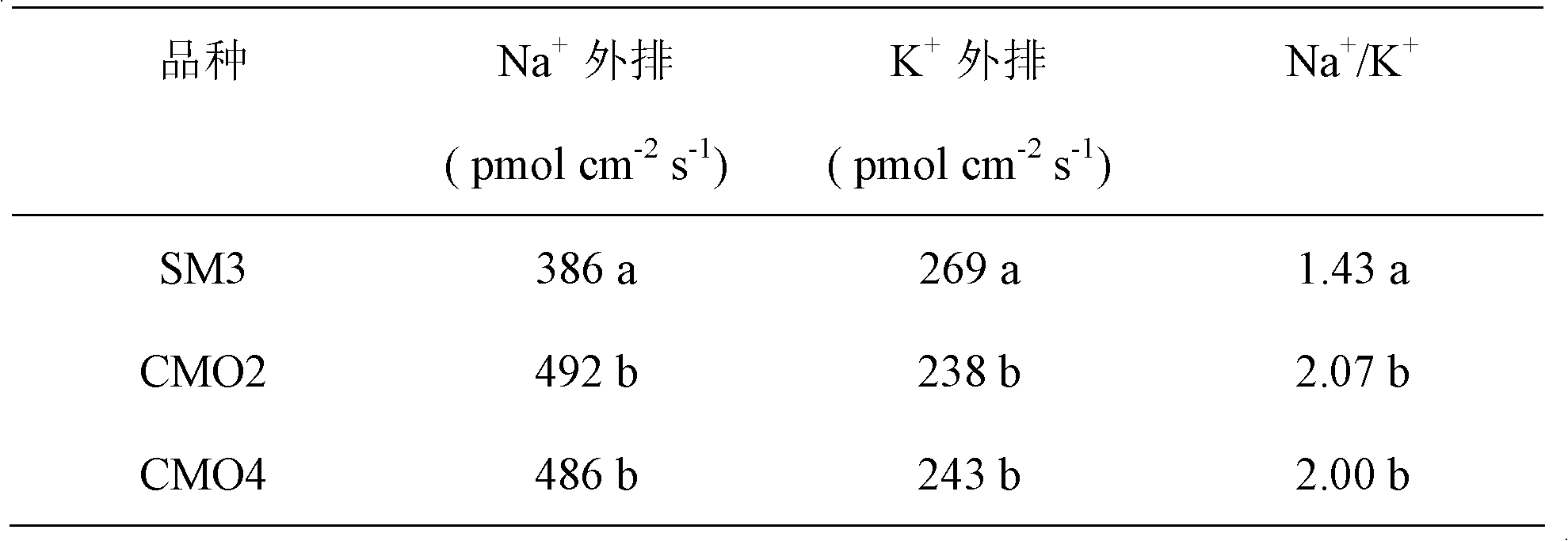Method for identifying salt tolerance of cotton
An identification method and a technology of salt tolerance, which are applied in horticultural methods, botanical equipment and methods, horticulture, etc., can solve the problems of long identification time, large floor area, and low efflux capacity, so as to reduce the pre-cultivation time, The effect of reducing errors and avoiding errors
- Summary
- Abstract
- Description
- Claims
- Application Information
AI Technical Summary
Problems solved by technology
Method used
Image
Examples
Embodiment 1
[0019] Get 3 sterilized petri dishes with a radius of 10 cm, put them into two filter papers of the same size respectively, and add 10 ml of sterilized double distilled water; put Si Mian No. 3 (SM3) and two strains of overexpressed mountain spinach CMO gene 20 develvet seeds of salt-tolerant cotton strains (CMO2 and CMO4) were soaked, peeled off the seed coats, sterilized with 0.1% mercuric chloride solution for 15 minutes, and then washed 6 times with sterilized double distilled water. In a dish, put it in a greenhouse (22-32°C) to germinate and emerge. After the cotyledons of the cotton seedlings were fully unfolded, 10 robust cotton seedlings of the same size were selected for each variety and placed in a seedling pot filled with Hoagland nutrient solution (22-32°C, humidity 60%-75%). Change every day. After the cotton grew one true leaf, three cotton seedlings with intact roots and the same size were selected from each line and treated with Hoagland nutrient solution con...
Embodiment 2
[0024] Take 2 sterilized petri dishes with a radius of 10 cm, put them into two filter papers of the same size, and add 10 ml of sterilized double distilled water; put the plump cotton (Lumianyan No. 28) and seaside mallow seeds 20 capsules each, peeled off the seed coat, soaked in 0.1% mercuric chloride solution for 15 minutes, then washed 6 times with sterilized double-distilled water, planted in the above-mentioned petri dishes respectively, and placed in a greenhouse (22-32°C) to germinate and emerge. After cotton (Lumianyan No. 28) and mallow cotyledons are fully expanded, select 10 strong seedlings of the same size and put them into a seedling pot filled with Hoagland nutrient solution (22~32°C, humidity 60%~75%) ), the nutrient solution was changed every two days. After one true leaf grew, three seedlings with complete root system and the same size were selected and treated with Hoagland nutrient solution containing 150 mM NaCl for 24 hours.
[0025] Table 2 Na in root...
PUM
| Property | Measurement | Unit |
|---|---|---|
| Length | aaaaa | aaaaa |
Abstract
Description
Claims
Application Information
 Login to View More
Login to View More - R&D
- Intellectual Property
- Life Sciences
- Materials
- Tech Scout
- Unparalleled Data Quality
- Higher Quality Content
- 60% Fewer Hallucinations
Browse by: Latest US Patents, China's latest patents, Technical Efficacy Thesaurus, Application Domain, Technology Topic, Popular Technical Reports.
© 2025 PatSnap. All rights reserved.Legal|Privacy policy|Modern Slavery Act Transparency Statement|Sitemap|About US| Contact US: help@patsnap.com


